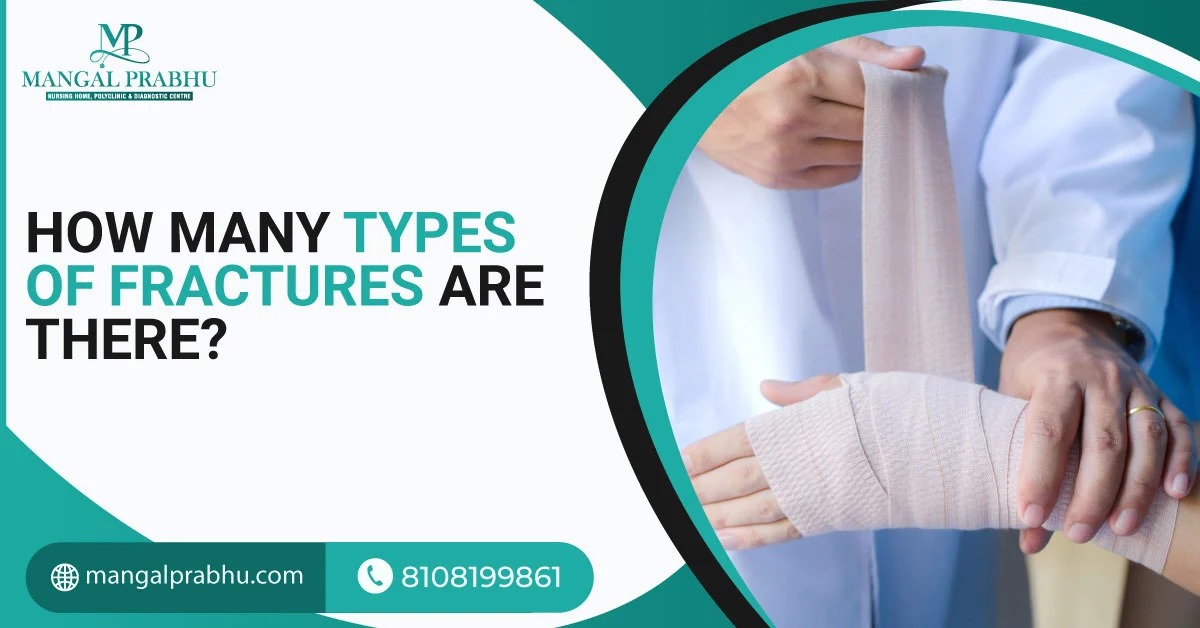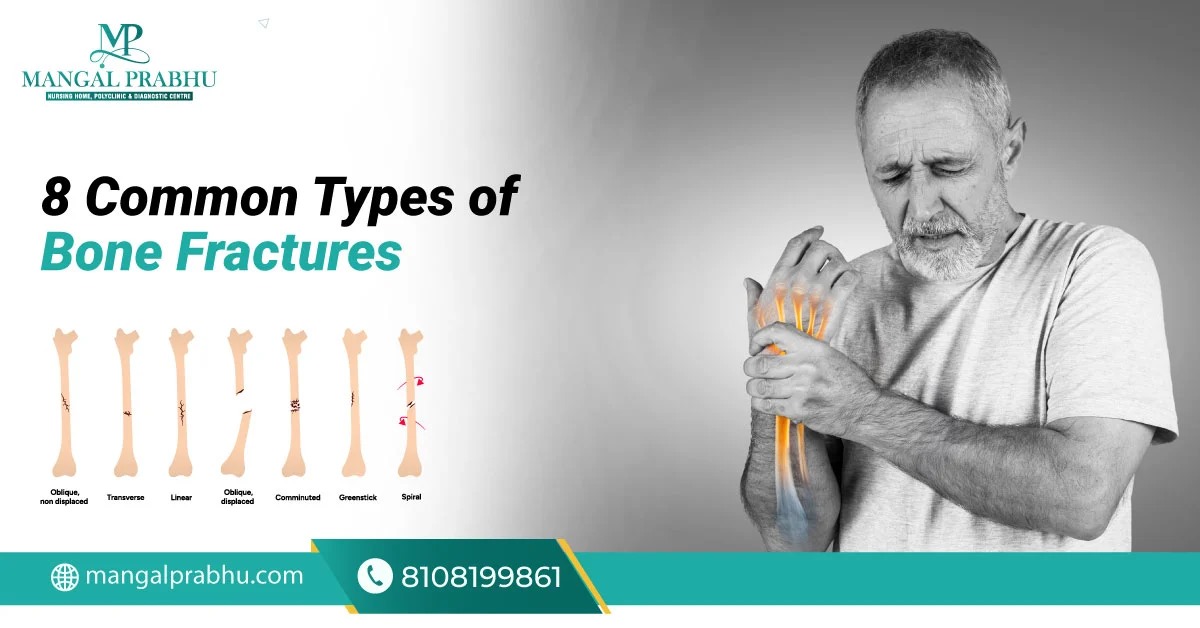
How Many Types of Fractures Are There?
Your bone density tends to decrease with age, increasing the risk of bone fracture. A bone fracture occurs when a heavy object hits your bones with a force greater than the bone can bear. The fracture can be minor; the bone may crack but doesn’t break completely. This can be fixed with casting and splinting. Or, it can be severe enough to break through the skin, increasing the risk of infection and other complications. In either case, it’s important to seek fracture treatment in Navi Mumbai to get your bones realigned. Read on to find out how many types of fractures are there.
Major Types of Fractures
a) Simple/Closed Fractures:
The bones break inside your skin but do not pierce through the skin. These are less complicated and often get better with immobilization and casting.
b) Compound/Open Fractures:
In a compound fracture, the bone fragments are visible on your skin. It creates a deep wound that requires immediate medical attention. You must see an orthopedic surgeon in Navi Mumbai to have it surgically repaired.
c) Greenstick Fractures:
Due to their increased bone flexibility, children are mainly affected by greenstick fractures. These occur when something hits their bones, breaking one side of the bone and bending the other.
d) Comminuted Fractures:
This is the worst type. The bones in comminuted fractures break into more than two pieces, often requiring a surgical repair. Because of their severity, comminuted fractures occur mostly during accidents and severe falls.
Specific Fracture Types
i) Transverse Fractures:
A transverse fracture results in the bone breaking horizontally into two pieces. It’s common in your leg or forearm bones. Treatment requires splints or surgery, depending on the severity of the damage.
ii) Oblique Fractures:
A sudden trauma to the bone can cause it to break diagonally. Oblique fractures are common in athletes, as they twist their arms and legs often during sports.
iii) Spiral Fractures:
Bones can also break spirally. Like oblique fractures, spiral fractures are common in people who forcefully twist their bones.
iv) Impacted Fractures:
Impacted fractures result in one end of the bone pushing into another due to serious trauma to the bones. These fractures can affect your ankles, hips, arms, and wrists. Since the bones do not break into pieces, you have a certain level of stability. That, however, doesn’t mean your bones are aligned. Treatment is required to restore your bones to their normal position.
Special Cases
A) Stress Fractures:
A fracture might occur from repetitive activities that put pressure on your bones. These are called stress fractures.
B) Pathologic Fractures:
These fractures occur because of a medical condition that can result in bone weakening to a degree that even a minor trauma can cause a severe fracture.
Prevention and Recovery
You can’t prevent situations, such as accidents or falls, that can lead to bone fractures. Here are a few tips that can help reduce your risk:
- Eat a diet rich in vitamin D and calcium
- Exercise regularly
- Resolve underlying medical conditions, such as osteoporosis.
Conclusion
Fractures are common during accidents and falls. Although anyone can get their bone fractured, people with low bone density are at an increased risk.

8 Types of Bone Fractures
Bone fracture refers to the broken or cracked bones. Although anyone at any age can experience a bone fracture, they are more common in older people (above 50 years). The risk is higher in people diagnosed with osteoporosis. Visit an orthopedic hospital in Navi Mumbai for bone density screening. The test detects weak and brittle bones and also suggests your likelihood of getting bone fractures. In the meantime, let’s explore the eight most common types of bone fractures.
8 Types of Bone Fractures
1) Simple Fracture
A simple fracture occurs when the bone breaks but does not cause any visible injury on the skin or break through your skin. There’s no severe tissue damage, as the bone is contained within your body. The bone might slightly displace or remain completely aligned with little damage to the soft tissue. Rest and immobilization are the most effective treatment options for simple fractures.
2) Compound Fractures
A compound fracture is more severe than a simple fracture. It occurs when the bone breaks and pierces your skin, leading to a severe wound. It’s caused by a fall from a great height or a car accident that puts excessive force on your bones, causing them to break and injure your skin. You will notice the bone sticking out of your skin and severe bleeding. See an orthopedic doctor in Navi Mumbai immediately if you notice these signs.
3) Comminuted Fractures
A car crash or other severe accident can result in your bone getting broken into many pieces. It’s another serious type of bone crack that requires hospitalization. The treatment for comminuted bone fractures is a surgical repair. The broken bones can take a year or longer to heal completely.
4) Greenstick Fractures
In greenstick fractures, your bone bends so much that it cracks slightly but does not break into multiple pieces. They result from sports injuries, falls, and other kinds of trauma. They are common in children, as children’s bones are weaker compared to adults.
5) Transverse Fractures
A transverse fracture is a bone crack that goes straight across the bone. It looks like a horizontal cut. The crack occurs from a fall or a heavy object hitting your bone. Immobilization is usually recommended for transverse fracture, but surgery might be needed if the bones’ alignment is affected.
6) Oblique Fractures
An oblique fracture is a diagonal crack, usually found in the long bones. These also occur from trauma to your bone due to a fall or an accident.
7) Spiral Fractures
Spiral fractures occur due to a sudden twisting motion, especially during strenuous physical activities or sports. These look like a corkscrew, a spiral line that goes all the way around the bone.
8) Compression Fractures
Compression fractures occur in the vertebra in your spine. They are most common in people with osteoporosis or a weakened spine, which is likely to collapse if you experience a fall, injury, or any accident that hits your spinal area.
Conclusion
Bone fractures are common and mostly occur because of trauma to your bones. These are more common in people with weaker bones (especially elders) than healthy ones. Treatment includes immobilization and surgery in severe cases.
